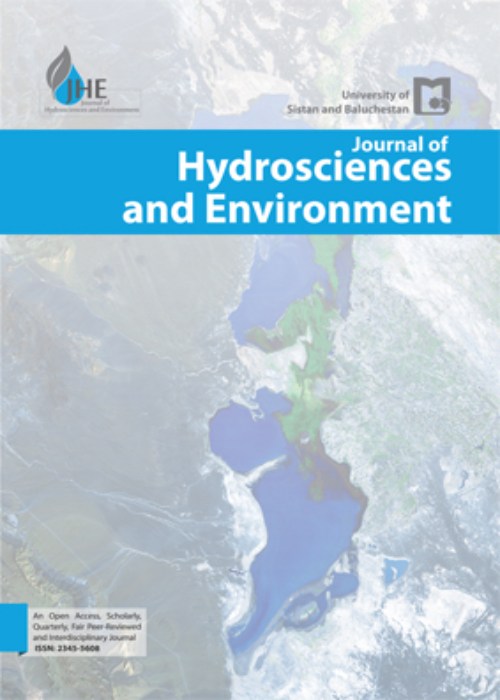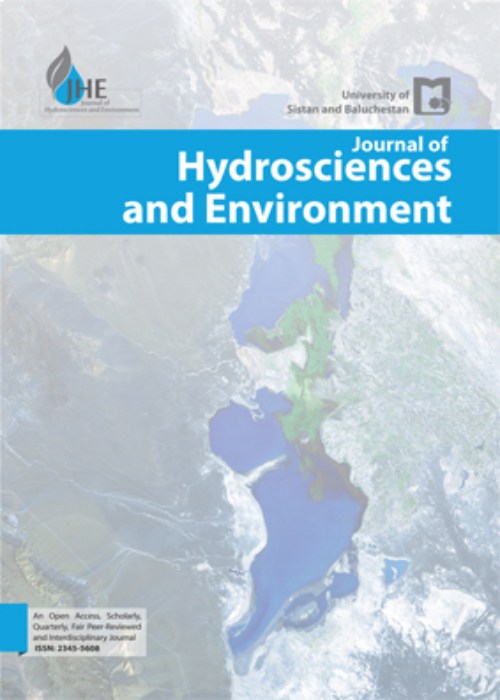فهرست مطالب

Journal of Hydrosciences and Environment
Volume:6 Issue: 11, Jun 2022
- تاریخ انتشار: 1402/03/24
- تعداد عناوین: 7
-
Pages 1-8
Modeling of river conditions and flood routing operations by numerical methods show a high accuracy.The beginning of the modern study of unsteady flow in open channels can be traced to the latter half of the nineteenth century when the French engineer Saint-Venant introduced the partial differential equations of continuity and momentum governing free surface flow in open channels. These equations are highly nonlinear and therefore do not have analytical solutions. This paper present the results of two different numerical methods, namely; Preissmann and Lax diffusive schemes for numerical solution of Saint-Venant equations that govern the propagation of flood wave, in natural rivers, with the objective of the better understanding of this propagation process. The results have shown that the hydraulic parameters play important game in the flood wave propagation. The results of these numerical solutions are compared with the MIKE.11 commercial computer model.
Keywords: Numerical method, Saint-Venant, Priessmann, Lax, MIKE 11 -
Pages 9-15The failure of a major flood control structure may expose the surrounding population to serious risk. Such an event kind may involve rapid transients with strong interactions between flow and topography. So, to correctly simulate the consequences of a dam failure in a complex topography, this interaction should be accounted for in mathematical modeling, which should however rely on physical descriptions that are not yet completely established. Present study explores some configurations for plane movable bed with different percent of bed slope across the dam. Experiments were carried out in an ideal flume, and instrumentation of the tests performed by means of fast digital imaging through the flume. Results show that increasing in slope lead to increasing in flow velocity and therefore increasing in eroding force and volume of transported sediment. Important result is that increasing in slope lead to nonlinear variation rate of scouring and sedimentation parameters.Keywords: Dam break, Slope effect, Experimental study, Image processing
-
Pages 16-23Accurate flow discharge prediction is very important in planning, designing, operating and maintenance of water resources structures. Various models have been developed so far to identify the relation between discharge and stage. In this study, artificial intelligent approach and conventional flow discharge rating curve models are considered for predicting flow discharge (FD) in a natural river. Discharge and stage data obtained from Ahar Chai River in northwest Iran. The accuracy of the ANN models is compared with conventional model. The determination coefficient (DC), coefficient of correlation (R2) and mean normalize error (MNE) statistics are used for evaluating the accuracy of the models. Based on the comparison results, the ANN models are found to be superior alternative to the conventional model.Keywords: Flow discharge prediction, intelligent approach, conventional model, determination coefficient, coefficient of correlation, mean normalize error
-
Pages 24-30Flood routing in matters relating to engineering projects, has many applications, and is designer to identify the effects of flood flows in the river helps. Muskingum method including flood routing methods that are using the recorded hydrograph based on flood characteristics and continuity equation to be provided routing unsteady flows. In the present study, in addition to the principles explaining the Muskingum methods, different techniques have been used to estimate the parameters of this method. The results for two different data sets Bvanlu River, superior method of least squares and correlation coefficients are shown.Keywords: Flood Routing, Unsteady Flow, Muskingum method, Parameters Optimizing, HEC-HMS
-
Pages 31-36Fluid-structure interaction (FSI) is a complex and critical field of study with a range of practical applications in the underwater domain. The present study investigates the FSI effect on two submerged steel structures consisting of ring-stiffened cylinders. The cylinder structures and the surrounding water are modeled using shell and acoustic finite elements, respectively. The study focuses on the dynamic response of the structures when subjected to an acoustic pressure shock wave. The results of the analysis, including the displacement and strain experienced by the structures, are presented and compared. This study provides valuable insights into the FSI effect on submerged structures, which has important implications for a wide range of applications. The findings of this study can contribute to the development of robust and efficient designs for submerged structures that can withstand the harsh underwater environmentsKeywords: Dynamic response, Fluid-Structure Interaction, Finite Element Analysis, Steel Cylinder
-
Pages 37-41
Sedimentation in river intakes causes many problems such as reduction of system delivery efficiency and increasing of maintenance costs. Several methods have been introduced for sediment control in river intakes and an effective method for preventing sediment entering into river intake is submerged vanes. The overall effective strategy for reducing bed sediment transport into the intake should be based on reducing the strength of the secondary flow and limiting the extent of the dividing stream surface at the bed. The objective of this study is to explore the possibility of applying an effective structure to control bed load sediment at the river intake. Current Deflecting Wall-Sill (CDW-Sill) was employed as a new method of controlling bed load sediment at river intake. The experiments were carried out under the live bed condition at the flow intensities (V/VC) of 1 and 1.1 for five hours. The relative discharges of the flow into the diversion which is defined as a ratio of diversion unit discharge to main channel unit discharge (qr) were equal to 0.2, 0.4 and 0.6. The results showed that the performance of the CDW-Sill, up to the available specific discharge ratio of 0.6, was better than the submerged vanes. However up to specific discharge ratio of 0.4, the width of primary CDW channel equal to 14 cm had the best performance which eliminated the sediment uptake.
Keywords: Current Deflecting Wall-Sill, River intake, Sediment reduction, Submerged Vanes -
Pages 42-48
Wave flood is the one kind of gradually varied flow. Flood prediction and flood control are very significant; therefore, one of the essential factors in design and evaluation of hydraulic structures and water resources planning is the prediction of flow discharge in rivers which is done by flood routing operation. Muskingum cunge is classified under hydraulic routing categories. This method has been used for modeling unsteady flows. Since this technique has sufficient accuracy, it does not need recorded data. In this study, in addition to the description of constant and variable parameters Muskingum-cunge method, the results were compared by numerical solution included kinematic wave using HEC-RAS software and dynamic model using Mike 11. Results represent that Muskingum-cunge method surely can be used for flood flow routing in rivers.
Keywords: Numerical solution, Unsteady Flow, Gradually Varied, Muskingum-Cunge, Kinematic Wave


